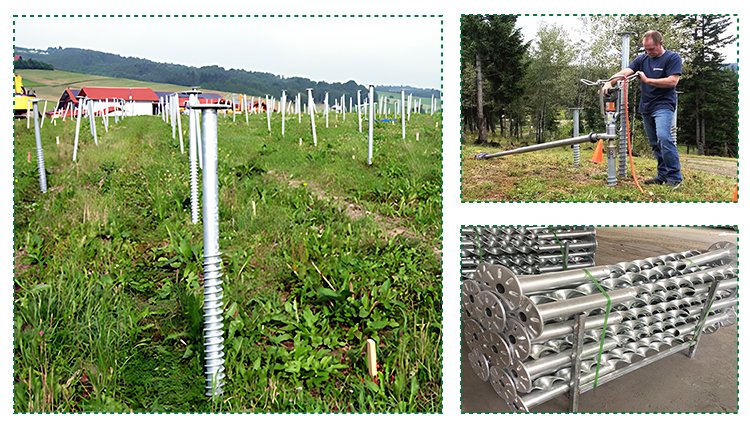-
2103 Kamer NO.322 Xinggang One Road, Haicang District, Xiamen Fujian, China

Screw Pile Pull-Out Strength Test: Overview and Why It’s Essential
Table of Contents
Screw piles are commonly used as foundations for solar power plants. However, before construction begins, it’s critical to assess the suitability of screw piles through a pull-out strength test. Failing to conduct this test can result in unnecessary expenses or structural failure.
This article explains the purpose, procedures, and increasing importance of pull-out tests for screw piles. It also covers why this test is becoming more common in both large-scale and residential solar projects.
What Is a Screw Pile Pull-Out Strength Test?
This test evaluates whether screw piles are appropriate for a specific site and helps determine the most efficient installation method. A screw pile is driven into the ground to a certain depth, then pulled upward using specialized machinery (e.g., applying 1,000 kg of force) to measure resistance.
- If the pile comes out easily, the soil lacks sufficient holding strength.
- If it holds firm, even a shorter screw pile may be sufficient, saving cost and labor.
🔧 Test Outcome Benefits:
- Reveals if soil reinforcement is necessary.
- Suggests optimal pile length.
- Informs appropriate installation method.

Why Is the Pull-Out Strength Test Important?
Screw pile foundations are cost-effective and quick to install. They don’t require curing time like concrete. However, they aren’t suitable for all ground types.
Examples of Risks:
- In hard soil, piles may bend or break without pre-drilling.
- In soft ground, insufficient resistance may lead to sinking or detachment.
Testing before the construction plan is finalized ensures:
- The selected pile type meets the strength requirement.
- Adjustments can be made early to avoid delays or accidents.
✅ Result: Safer construction and more efficient project execution.
Common Screw Pile Installation Methods
When the Ground is Hard
- Issue: Hard layers (e.g., bedrock) make direct driving difficult.
- Solution: Pre-drilling is essential.
- Drilling methods include:
- Air-blast rotary drilling.
- Auger + vibration head drilling.
- Drilling methods include:
Pre-drilling improves accuracy and reduces pile damage.
When the Ground is Soft
- Issue: Easy to insert, but stability may be compromised.
- Solution: Use long piles or wide-blade screw piles (“large wing type”) that resist vertical and lateral forces better.
- In extremely soft soil, concrete foundations might be more practical.

What Does the Pull-Out Strength Test Include?
There are three main testing methods:
1. Pull-Out Test (Vertical and Horizontal Load Test)
- A screw pile is installed to depth and pulled vertically/horizontally.
- Equipment options:
- Excavator with load gauge.
- Hydraulic jack with tripod or reaction frames.
Typical loads tested: 200 kg to 2,000 kg depending on conditions.
Use Case:
To simulate wind uplift or lateral force from storms acting on solar panels.
2. SWS Test (Screw Weight Sounding Test)
- Also known as the Sweden Sounding Test.
- A weighted rod with a screw point is rotated into the ground.
- Measures N-values (soil resistance).
Test types:
- Manual
- Semi-automatic
- Fully automatic
🔍 Commonly used in Japan for residential sites. Offers cost-effective soil profiling up to ~10m depth.

3. Compression (Push-In) Test
- Measures ground support by applying downward force to a pile.
- Assesses risk of settlement under snow load or equipment weight.
Especially recommended in:
- Snowy regions (e.g., Hokkaido, Japan).
- Wind-prone areas where strong downward pressure is expected.
Why Strength Testing is Increasing
1. Regulation Changes
Japan implemented a “Pre-Use Self-Inspection System” in 2016 for systems above 500kW. Installers must now verify strength and report results before operation.
- Triggered by accidents like:
- Panels flying off during typhoons.
- Soil erosion and landslides during heavy rain.
Even low-voltage systems (<50kW) are increasingly tested due to rising quality standards.
2. Industry Trend: Safety Over Cost
Testing both pull-out and push-in strength helps ensure:
- No post-installation sinking.
- No equipment detachment due to wind or seismic events.
- Long-term project viability and stable returns.

Final Thoughts: Plan Your Foundation with Confidence
Screw pile strength tests are no longer optional—they’re essential for safe, efficient solar installations. Whether you’re working on a large-scale solar power plant or a small residential project, testing helps you:
- Prevent accidents.
- Avoid construction delays.
- Optimize costs.
👷 Need Help? Get in Touch with Firstsolar’s Screw Pile Experts
Let us assist you in choosing the right pile type, length, and installation method based on your site’s soil conditions.








